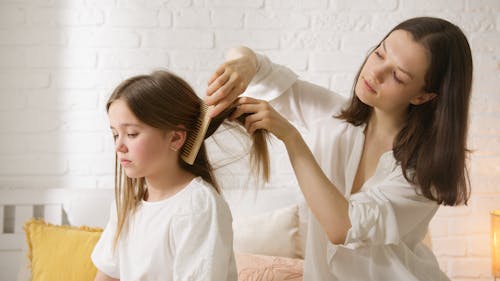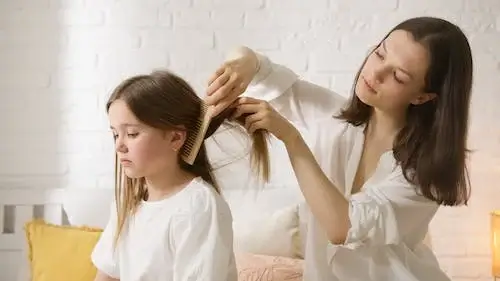Introduction
Hair loss in children can be an upsetting situation for parents. because hair loss is usually associated with getting older, it may happen in young people for several reasons. Knowing the reasons and risks of hair loss in children makes it important for parents to deal with the problem properly and provide the necessary support. This article explores various factors that lead to hair loss in kids and highlights possible issues.

Is it normal for a child to lose hair?
To some point, hair loss in children is natural. A particular amount of hair loss is a normal part of the hair growth cycle. Heavy or inconsistent hair loss, on the other hand, could indicate a deeper issue. Hair loss for kids can be caused by genetics, health conditions, eating habits inadequacies, or improper hair care practices. If parents have concerns or detect strange patterns, they should seek the advice of a healthcare expert.
What deficiency causes hair loss in children?
Nutrient deficiencies, especially a lack of iron, zinc, biotin, and vitamin D, can all contribute to hair loss in children. These nutrients are required for proper hair development. A nutritious meal plan along with professional guidance can help reduce deficiencies and encourage healthy hair development.
How much hair loss is normal for children?
Children usually lose 50 to 100 hairs each day, which is within the normal range of hair loss. However, if a kid has significant hair loss, such as apparent thinning or patchy bald areas, he or she should see a doctor for a further examination.
Types of hair loss in Childhood
Alopecia areata
Alopecia areata is a kind of hair loss that appears in children. and adults. It is a condition caused by an autoimmune disease in which the immune system attacks the hair cells by mistake, leading to sudden hair loss.
It may turn out in bald spots on the scalp, brows, or other hair-bearing areas that are oval or round in shape. Alopecia totalis (full loss of scalp hair) or alopecia universalis (complete loss of hair from the whole body) may occur in certain situations.
The exact cause of the condition is unknown, however, it is thought to be a mix of inherited and environmental causes. Treatment options for hair regrowth may include oral or injectable medicines.
Telogen Effluvium
Another kind of hair loss that is typical in children is telogen effluvium. It happens when the hair development cycle gets disrupted, resulting in a lot of hair loss. Physical or emotional stress, sickness, nutritional deficiencies, medicine usage, or hormonal changes can all produce this.
Telogen effluvium is marked by broad hair loss rather than separated bald spots. The condition tends to be temporary, and hair growth usually returns after the root cause is treated or cured.
Trichotillomania
Trichotillomania is a hair loss disease that includes an obsession to pluck one’s own hair out. It is common in young people and is recognised as a psychological disorder. Hair pulling may be used by children with trichotillomania to deal with stress, worry, or other psychological difficulties.
Hair loss patterns can range from local patches to broad baldness. To help children overcome the need to pull out their hair, trichotillomania treatment can consist of a combination of behavioural therapy, counselling, and support.
Diagnosis of hair loss in children
Physical Exam
A physical examination is a common way to diagnose hair loss in children. A doctor or nurse will carefully examine the child’s scalp, hair, and general density of hair all through the examination.
They will search for specific hair loss patterns, such as patchy bald areas, thin hair, or general hair loss. The checkup might involve examining for symptoms of inflammation, infection, or scaling on the scalp.
In addition, the doctor may check other parts of the body to look for symptoms or indicators of an actual medical disease.
Lab Testing
Laboratory tests may be suggested in rare circumstances to help find the cause of hair loss in kids. Blood tests can be used to figure out the levels of particular hormones, nutrients, or markers of inflammation. These tests may help in the diagnosis of deeper issues such as thyroid abnormalities, nutrient deficiencies, or autoimmune disorders.
A hair pull test may also be used to evaluate the amount of hair lost during a mild pull, which may provide information on the hair growth process and possible causes of hair loss.
Family History
The value of family history for recognising hair loss in children cannot be overstated. Studying a family member’s medical background, particularly related to hair loss, may provide useful information.
Some diseases, such as androgenetic hair loss, may have a genetic component, and understanding if such conditions exist in close relatives might help with diagnosis. The doctor may enquire about hair loss patterns in family members and the age at which the hair loss began.
Treatment of hair loss in children
Medication
Some types of hair loss in children might need medication as part of the treatment routine. The medication that is suggested will be based on the root cause of the hair loss. Oral or injectable steroids, for example, may be used to lower the immune system response and encourage hair regrowth in cases of alopecia areata, or hair loss.
In particular situations, various medications, such as minoxidil, may be used to encourage hair growth. Parents have to strictly stick to the healthcare professional’s advice regarding medicine use, dosage, and any side effects.
Therapy
Therapy may prove successful at treating hair loss in kids, especially when psychological or behavioural problems are present. Therapy, which includes cognitive-behavioural therapy (CBT), may help kids who have trichotillomania identify causes, develop ways to cope, and reduce hair-pulling habits.
Counselling or peer support groups can also give emotional support, boost self-esteem, and help children in managing the difficulties related to hair loss. Working with mental health specialists can give important direction and support during the treatment process.
Surgery
In certain situations, surgical treatments may be examined as a therapy option for paediatric hair loss. Hair transplantation is mainly chosen by older children and teenagers suffering from specific kinds of hair loss, such as androgenetic hair loss or scar loss.
These treatments include transplanting healthy hair follicles from one part of the scalp to areas with thinning or no hair. When every other option for therapy has been tried and the child’s emotional and physical development supports such operations, surgical procedures are usually carried out.
Prevention of hair loss in children
Healthy Diet

A healthy diet is necessary for hair growth. Because it decreases hair loss in kids. A diet that is high in nutrients, which include vitamins (including biotin and vitamin D), minerals (such as iron and zinc), and proteins, may contribute to the development of strong, bright hair.
Encourage your children to eat a variety of foods, like fruits and vegetables, whole grains, lean proteins, and healthy fats. Consult a doctor or a qualified dietitian if required to ensure the child’s diet is balanced and satisfies their nutritional needs.
Related: Fuel for Success: 7 Strategies for Balancing Student Life, Diet, and Optimal Performance.
Stress Management
Children’s hair loss can be worsened by stress, therefore teaching them effective stress management strategies is essential.
Encourage common exercise because it can help relieve stress. Make your home a caring and protective environment for your children, with open communication and opportunity for them to express their feelings.
Activities that cause calmness, such as reading, listening to music, or using meditation methods, may be helpful in stress management. We can reduce the effects of stress on children’s entire well-being, including their hair health, by helping them to learn appropriate ways to cope.
Related: 4 Signs of Childhood Trauma: How It Can Impact Your Mental Health as an Adult.
Proper Grooming
Proper hair care practises can help reduce hair loss in kids. Avoid tight hairstyles that tug on the hair, because this can cause hair follicle damage. Encourage children to use delicate hair products and to avoid using too much heat or harsh products when styling their hair.
Washing and conditioning the hair on a regular basis with mild, child-friendly solutions can help maintain a healthy scalp. Educate children to treat their hair gently, avoiding heavy tugging, or brushing when it is wet since wet hair is more prone to breaking.
Conclusion
If your kid is having hair loss, it is important that you get the guidance of a healthcare specialist. A good diet, stress management, and gentle hair care are all helpful to maintain hair health. According to the root cause of hair loss in children, treatment options may include medication, counselling, or surgery if necessary.
You can help your child manage this situation and encourage healthy growth of hair while also supporting their mental well-being by being active and getting proper care. Remember that early treatment along with regular follow-up are essential for effective hair loss control in children.


